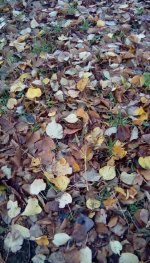Hinksey Hill Wander


By markle
- 804 reads
It was a fresh autumn day, the air cool but green still in the leaves. We had crossed the ever-fumy A34 at the South Hinksey footbridge, and soon were treading a familiar trail along the hedge line. Even in late September the grass stands hip high beside the path, all banners of spent seed in varying shades of gold. The field beside us was mostly bare earth. Scattered across the grey-brown expanse were flints was a peculiar harvest: fossils.
On this side of Hinksey Hill the clay has recently been disturbed. This has brought to the surface the cracked shells of oysters, conglomerate stones filled with bivalves and occasionally single discs of shells, all dating from the Jurassic when the county was covered by a rich tropical sea.
My favourites are the oyster shells, a centimetre or two thick. Complete, they would be more than a hand’s span across. Broken, they reveal their own sedimentary layers, one for each year of the oyster’s life. It can take quite a time to reach the top of the hill.
Eventually – also being distracted by a kestrel flying ahead of us – we reached the duckboards that lead through the fens of Happy Valley. Unlike the open field, the first part of the fen is quite closed in. There were a few butterflies and bees drifting about, all with an autumn drowsiness. This fen is a very rare habitat, home to species very close to vanishing from the UK.
We cross a little stream in the channel it has bored through thick vegetation. Long-fingered mosses stretch themselves out into the striated surface of the water, shifting between shadow and streaks of light. Then we are into the trees.
They are a mix, oak, lime, hawthorn, willow. Some stand tall, spreading canopy high over our heads, creating a cool, moist realm where the path is always muddy and fuzzes of moss cover the sides of thick trunks. Below the high branches the slopes of the valley angle down to the stream, where sandy patches among the leaf litter show deer, badger, fox, dog and human prints.
Fallen trees lie here and there across the channel, excellent bridges for the adventurous to go exploring. Others might like to crouch among the stones on the stream bottom, picking out ones that have been polished to gleaming brilliance and shine with wetness – almost jewels compared with the dusty, muddy grey fossils of the field.
Fallen branches are patterned with fungi and mould, giving up their shapes to the knobbliness of decay. More extravagant forms are presented by trees that have fallen and risen again, arcing down into the ground, then up, sprouting etiolated side branches crowned with fragile leaves, dappled with galls and other strange blotches. It’s as easy to spend time in the woods as picking over the fossils outside.
We passed out into the open air again, felt its warmth, heard the chatter of jackdaws and the high call of a red kite, but our minds were half back in the damp under the trees. We ought to have been admiring the rosehips red like a shock, and the last remaining yellow flowers by the side of the path. We did enjoy sticking burrs to each others’ clothes. The seeds, presumably, were scattered in our wake.
We passed under a great oak, stretching up over us, and shortly after the path turned almost back on itself, sloping up from the valley bottom. The ground was soft, but many crab apples had fallen, brown and squishy at the core but staying crunchy outside. A faint appley smell hung around us as we made our way over this excellent harvest for mice and birds stocking up for the winter.
The path soon flattens out to a broad track between big sloe bushes and the sharp slope down to the stream. The skeletons of blooms hung as from gallows over the yellowing grass. It was only at first glance that it seemed macabre. This is a healthy meadow and this was simply one of the stages in its annual cycle. It always pays to linger and look down over the sward into the trees. This time, a green woodpecker launched loudly and iridescently past us.
We came to the gate that took us back out to the fossil field. We looked out over Oxford, seemingly cupped in the palm of the wider valley, and from this distance, quite still. But the path home heads down towards the A34.
First published in Oxford Magazine.
- Log in to post comments


